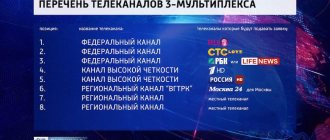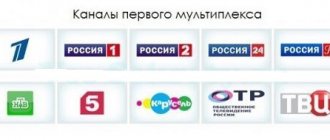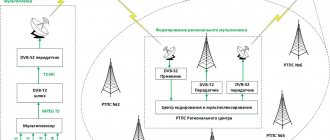The first and second multiplexes (packages of free TV channels) are broadcast almost throughout Russia. The RTRS enterprise, the Russian radio and television network, is responsible for the terrestrial broadcast of all public channels.
The third multiplex or the development of a new project is a possible prospect for the further development of the digital terrestrial television (DTTV) network in our country. Questions about what multiplexes are and what channels will make up the third digital television package (RTRS-3) will be discussed below.
What are digital television multiplexes?
The literal meaning of the English word “multiplex” is a set of identical elements. When it comes to digital television, a multiplex should be understood as a package of television channels. TV channels in one package are united by the frequency at which they are all broadcast. Different regions of the country use different frequencies. The signal is transmitted by a transmitter installed on the TV tower.
As of January 2021, the first package of digital television (over 98.4% coverage) and the second (over 98% coverage) are broadcast almost everywhere. Each of them includes 10 free ones. In total, 20 channels broadcast freely throughout almost the entire territory of our country.
In hard-to-reach settlements, installing television towers with transmitters does not seem cost-effective, so access to digital will be achieved through direct satellite broadcasting. This step will significantly reduce the cost of providing citizens living there with high-quality digital television.
Second digital multiplex
Digital broadcasting of the second multiplex package was carried out in every region of the Russian Federation throughout 2021. It covers more than 98% of the entire territory of the country. For remote and sparsely populated areas, viewing channels is possible using satellite television.
What channels are included in RTRS-2?
From 2012 to 2015, the channels included in the second multiplex underwent a competitive selection by the Federal Commission on Television and Radio Broadcasting. Their list has been approved by Roskomnadzor:
- "Home";
- "Star";
- "World";
- "Muz TV";
- "Friday";
- “RenTV”;
- "Saved";
- “STS”;
- “TV-3”;
- "TNT".
These are mainly specialized or entertainment-oriented channels.
The specificity of RTRS-2 is that it does not include radio broadcasting.
Frequencies
The channels included in the second multiplex received operating frequencies in the UHF range from 470 MHz to 862 MHz. To configure the reception of a package of TV channels, also use the following technical specifications:
- main format - DVB-T2;
- The current standard definition format is SDTV;
- operating frequency of broadcasting is 498 MHz.
To receive the signal in each region, different frequencies are used in the range from 471 to 950 MHz, that is, from 21 to 80 television channels with an assigned frequency section.
The correspondence is shown in the table below. Use its data when setting up a second multiplex in your region. It is enough to know the number of the channel on which the digital signal is broadcast, and enter its number when searching:
| Channel no. | Center frequency (MHz) | Central wavelength (cm) |
| 21 | 474,5 | 63,2 |
| 22 | 482,5 | 62,2 |
| 23 | 490,5 | 61,2 |
| 24 | 498,5 | 60,2 |
| 25 | 506,5 | 59,2 |
| 26 | 514,5 | 58,3 |
| 27 | 522,5 | 57,4 |
| 28 | 530,5 | 56,6 |
| 29 | 538,5 | 55,7 |
| 30 | 546,5 | 54,9 |
| 31 | 554,5 | 54,1 |
| 32 | 562,5 | 53,3 |
| 33 | 570,5 | 52,6 |
| 34 | 578,5 | 51,9 |
| 35 | 586,5 | 51,1 |
| 36 | 594,5 | 50,4 |
| 37 | 602,5 | 49,8 |
| 38 | 610,5 | 49,1 |
| 39 | 618,5 | 48,5 |
| 40 | 626,5 | 47,9 |
| 41 | 634,5 | 47,3 |
| 42 | 642,5 | 46,7 |
| 43 | 650,5 | 46,1 |
| 44 | 658,5 | 45,6 |
| 45 | 666,5 | 45,0 |
| 46 | 674,5 | 44,5 |
| 47 | 682,5 | 44,0 |
| 48 | 690,5 | 43,5 |
| 49 | 698,5 | 43,0 |
| 50 | 706,5 | 42,5 |
| 51 | 714,5 | 42,0 |
| 52 | 722,5 | 41,5 |
| 53 | 730,5 | 41,1 |
| 54 | 738,5 | 40,6 |
| 55 | 746,5 | 40,2 |
| 56 | 754,5 | 39,8 |
| 57 | 762,5 | 39,3 |
| 58 | 770,5 | 38,9 |
| 59 | 778,5 | 38,5 |
| 60 | 786,5 | 38,1 |
| 61 | 794,5 | 37,7 |
| 62 | 802,5 | 37,4 |
| 63 | 810,5 | 37,0 |
| 64 | 818,5 | 36,7 |
| 65 | 826,5 | 36,3 |
| 66 | 834,5 | 36,0 |
| 67 | 842,5 | 35,6 |
| 68 | 850,5 | 35,2 |
| 69 | 858,5 | 34,9 |
| 70 | 866,5 | 34,6 |
| 71 | 874,5 | 34,3 |
| 72 | 882,5 | 33,9 |
| 73 | 890,5 | 33,6 |
| 74 | 898,5 | 33,3 |
| 75 | 906,5 | 33,0 |
| 76 | 914,5 | 32,8 |
| 77 | 922,5 | 32,5 |
| 78 | 930,5 | 32,2 |
| 79 | 938,5 | 31,9 |
| 80 | 946,5 | 31,7 |
First package of TV channels
The list includes:
- First channel;
- Russia 1;
- Russia K;
- Russia 24;
- Channel 5;
- NTV;
- OTR;
- TV Center;
- Match TV;
- Carousel.
The first seven TV channels are federal, Match TV shows sports programs, and Karusel shows programs for children. This list was compiled by presidential decrees between June 2009 and July 2015.
Attention! Today RTRS-1 is broadcast wherever there is access to digital television.
Second multiplex (RTRS-2)
Added recently, not yet available (as of September 21, 2019) in all regions, but is being gradually implemented. Connection schedule.
| TV channel | Frequency, MHz |
| Saved | 498 |
| TNT | 498 |
| STS | 498 |
| Home | 498 |
| World | 498 |
| Friday! | 498 |
| Star | 498 |
| TV3 | 498 |
| REN TV | 498 |
| Muz TV | 498 |
Launch of the second multiplex
A competitive selection conducted by the Federal Television and Radio Broadcasting Commission in several stages (from 2012 to 2015) determined the list of channels for the second multiplex. It included:
- REN TV;
- STS;
- Home;
- TV 3;
- Friday;
- TNT;
- SAVED;
- Star;
- World;
- Muz TV.
Ten more free TV channels of various subjects began to be added gradually. At the end of 2021, the last digital broadcast facility of the second multiplex was launched. The transmitter was mounted on a television tower in the village of Kurush in the Republic of Dagestan. Like many other transmitters, the iconic device was in standby mode for some time. In order to ensure relative equality of citizens in terms of access to modern television, it was decided to make the final stage of the launch large-scale. Therefore, the peak of connection occurred in November and December 2021.
You can find out in which district and locality the RTRS-2 package is currently being broadcast using an interactive map. Her page is located at map.rtrs.rf. To see the approximate broadcast coverage area, you need to do the following:
1) enter the address or name of the object in the search bar (or select any place on the map);
2) in the window that opens, click on the black end of the arrow indicating the direction to the nearest TV tower;
3) mark the package of RTRS-2 TV channels to see the broadcast coverage area (highlighted in red or blue).
Criteria by which channels are selected for the third multiplex
- First of all, 24-hour broadcasting.
- A large list of programs of our own production or programs purchased from other channels.
- Popularity with viewers.
- Financial condition of the media resource.
- compulsory broadcasting in analogue mode.
- Availability of social programs.
As for the third package, the selection concept has changed somewhat. It can only include those channels that are not in the previous two. The following channels are considered candidates for the new multiplex: Dozhd, Russia Today, Friday, 2×2, as well as some others. While there is no final decision on the third multiplex, the government will make it in the near future.
The new multiplex is planned to be launched this year. As for the current state of affairs, the launch is complicated by the fact that in each region the possibilities of the advertising market do not allow the opportunity to pay for the supply of a signal in digital form. Not a single local TV channel can afford this, since it will also have to broadcast in analogue mode and have a presence in the cable.
Also in February, a decree was issued not to turn off analogue television; the shutdown date was postponed indefinitely. Broadcasting in analogue mode will be switched off gradually; the plan for switching off analogue TV is presented in the article, and there are no threats for advertisers in this regard.
Launch of the third multiplex
Despite the fact that the third digital TV multiplex (RTRS-3) is a desirable product for TV viewers in our country, the project is temporarily frozen. The main reason lies in the economic side of the issue. The implementation of another large project will require significant financial investments. In addition, not all potential participants may qualify to be included on the list.
Another important condition that would allow the launch of the third package is the need to free up frequencies. Analog TV channels currently occupy a large range. The plan for the gradual shutdown of analogue broadcasting is presented on the RTRS website (the section is called “When will analogue TV channels be turned off”).
Despite the temporary freeze of the project, work in this direction continues. It is not yet possible to name the exact release date of the new package. The chronicle of the development of digital television and the latest news can be followed in the relevant sections of the RTRS website.
Which channels can be included in the third multiplex
There is no definite answer to the question of what the list of channels of the third multiplex in 2021 will be. It is also impossible to say for sure whether they will connect the new package to the existing two in free mode.
The first regions where RTRS-3, the third package, appeared and began to be broadcast were Crimea and Sevastopol. Regional channels play a significant role here:
- First Crimean;
- Millet;
- Information channel of Sevastopol;
- Crimea 24.
In addition to these TV channels, Moscow 24 and Mir 24 are broadcast in the regions.
RTRS-3 in the Moscow region
Moscow has also connected to the third multiplex, but so far in test mode. In accordance with the established schedule, 40 licensed channels broadcast for several hours a day. In this case, TVK34 and a frequency of 578 MHz are used. As for the contenders for the title of channel of the third multiplex, the choice will be made precisely from these 40 TV channels licensed by Roskomnadzor. Among them are: Sports 2, Fight Club, My Planet, Russian Detective, Cartoon, Mom, House of Cinema, 365 Days of TV, Auto Plus, A Minor, etc.
Latest news on the RTRS RF website - https://moscow.rtrs.ru/tv/digital/
Channels of the 3rd digital TV package
The first two packages of digital TV channels are mainly represented by federal programs with round-the-clock broadcasting. It is planned to include local channels in the third multiplex, i.e. Each region will have its own set of television programs. For Moscow, this list has already been approved. The table below presents a list of TV channels of the 3rd digital television multiplex, which residents of the capital and surrounding districts can now receive.
| Position | Name | Number | Frequency, MHz | Broadcasting time, h/week |
| 1 | Sports 1 | 34 | 578 | Around the clock |
| 2 | Sports 2 | 34 | 578 | 00:00-06:00 (42) |
| Fight club | 34 | 578 | 06:00-12:00 (42) | |
| My planet | 34 | 578 | 12:00-18:00 (42) | |
| Science 2.0 | 34 | 578 | 18:00-00:00 (42) | |
| 3 | Russian novel | 34 | 578 | 00:00-05:00 (35) |
| Russian bestseller | 34 | 578 | 05:00-10:00 (35) | |
| Russian detective | 34 | 578 | 10:00-15:00 (35) | |
| Story | 34 | 578 | 15:00-20:00 (35) | |
| Cartoon | 34 | 578 | 20:00-00:00 (35) | |
| 4 | Sundress | 34 | 578 | 00:00-12:00 (84) |
| A country | 34 | 578 | 12:00-00:00 (84) | |
| 5 | Living Planet | 34 | 578 | 00:00-06:00 (42) |
| IQ HD (SD quality) | 34 | 578 | 06:00-09:00 (21) | |
| 24 Doc | 34 | 578 | 09:00-12:00 (21) | |
| Techno 24 | 34 | 578 | 12:00-15:00 (21) | |
| Mother | 34 | 578 | 15:00-18:00 (21) | |
| NST | 34 | 578 | 18:00-21:00 (21) | |
| Amusement park | 34 | 578 | 21:00-00:00 (21) | |
| 6 | Moscow. Confidence | 34 | 578 | 00:00-12:00 (84) |
| euronews | 34 | 578 | 12:00-00:00 (84) | |
| 7 | Music of the First | 34 | 578 | 08:30-01:30 (119) |
| Home Cinema | 34 | 578 | 01:30-02:30 (7) | |
| Time | 34 | 578 | 02:30-04:30 (14) | |
| TV cafe | 34 | 578 | 04:30-06:30 (14) | |
| Beaver | 34 | 578 | 06:30-08:30 (14) | |
| 8 | 365 days of TV | 34 | 578 | 00:00-02:00 (14) |
| TNT-Comedy | 34 | 578 | 02:00-04:00 (14) | |
| Lots of TV | 34 | 578 | 04:00-06:00 (14) | |
| HD Life (SD quality) | 34 | 578 | 06:00-08:00 (14) | |
| STV | 34 | 578 | 08:00-10:00 (14) | |
| India TV | 34 | 578 | 10:00-12:00 (14) | |
| Fighter | 34 | 578 | 12:00-14:00 (14) | |
| Comedy TV | 34 | 578 | 14:00-16:00 (14) | |
| La Minor | 34 | 578 | 16:00-18:00 (14) | |
| Men's cinema | 34 | 578 | 18:00-20:00 (14) | |
| Kitchen TV | 34 | 578 | 20:00-22:00 (14) | |
| Auto Plus | 34 | 578 | 22:00-00:00 (14) | |
| 9 | LifeNews | 34 | 578 | Around the clock |
| 10 | Our football | 34 | 578 | Blocked |
As you can see, there are 40 channels in total, but most do not broadcast around the clock. The total amount of broadcast time is comparable to the round-the-clock broadcast of 10 channels, which corresponds to the volume of the other two multiplexes.
The list of these channels has not yet been fully approved, and it is unknown whether this will be the case for digital TV in Russia before the official release of the 3rd package. However, all existing channels (listed in the table) already have a broadcast license dated December 31, 2014.
Channel selection criteria
Not every TV channel can be included in the 3rd package. Only those who meet the following criteria will be broadcast:
Work 24/7
A person can turn on the TV at any time early in the morning or late at night. It is beneficial for the authors of the project that people stay to watch one of the programs. Therefore, round-the-clock work is one of the main criteria.
Demand.
If a TV channel is not in demand, then people don’t watch it much. Because the number of places on air is limited, such candidates fade into the background. They have almost no chance of getting on the list.
Availability of many gears
Monotonous programs quickly bore viewers. This leads to loss of views, and therefore money. Because of this, the channel may become unclaimed.
Channel operation on analogue broadcasting
The developers of the 3rd multiplex want to see how the TV channel works. What is its profitability? If everything is in order and it meets the other criteria, then there is every chance of passing.
Problems of the new multiplex
The launch of the third multiplex is temporarily difficult due to two problems:
- Elimination of broadcast television.
- Definition with a list of programs.
Broadcasting
Standard analogue broadcasting takes up too much air space. There is not enough space for digital.
Many TV channels are switching to digital, but they do not have a unified plan. The presence of regional and regional programs greatly slows down the transition process.
List of programs
To be included in the list of programs that the new multiplex will broadcast, each TV channel must pass a competition and also meet very strict limits. In addition to this, each region will have its own list of programs, and this slows down the process even more.
Multiplex 3 release date
A Decree on the initial multiplex was adopted in 2009. Initial free digital TV carriers were introduced. Then in 2012 a second multiplex was released, supplemented by 10 positions.
The third multiplex has been operating since 2015. Improved quality with DVB-T2 format.
At the request of Roskomnadzor, TV channels will broadcast programs according to a specific schedule in order of rotation. This approach was developed in connection with the Law “On Advertising,” which prohibits broadcasting advertising for positions with a paid basis or coded ones. As a result, free broadcasting is required for the restriction to not be valid.
Which channels will be included in the third multiplex?
Initially, it was planned that the third digital television multiplex in Russia would consist of: 1 channel in HD, 1 regional TV channel produced by VGTRK and four regional channels from different regions. However, over the years the concept has changed. In 2013, it was decided that set 3 would include 10 TV channels in SD quality:
- 7-8 federal;
- 1-2 from regions;
- 1 from VGTRK.
They were going to involve TV channels in the creation of the third set that were not included in the second: 2x2, Rain, Friday and others.
Currently it is planned that channels 3 of the multiplex will be predominantly regional. They will be selected on a competitive basis. The main selection principles are:
- Possibility of round-the-clock broadcasting;
- percentage of self-produced content;
- audience interest in the channel;
- concept;
- financial well-being;
- social significance of the TV channel.
Important! Participants in the competition can attract federal TV and radio companies that were not included in the second package as network partners.
How to set up (instructions and video)
Russian RTRS-3 can be configured by analogy with other multiplexes. Knowing the operating frequency:
- Using the remote control, go to the TV menu.
- A list should appear there where you can select “DVB-T/T2 Settings” .
- Next, select “Channel Search” .
- Then scroll through the frequency charts until you reach the number 34 and a value of 578 MHz.
- Check the signal strength. If it is 60% or higher, start searching. Otherwise, a weak signal will not allow you to properly watch free channels.
Saving regional broadcasters is the job of regional operators
Pay TV operators surveyed by Telesputnik are generally positive about broadcasting local TV channels in their packages, but they doubt that a third multiplex can become an equally significant factor in supporting regional broadcasters.
“If the goal of the third multiplex is to support regional channels, then I don’t think that our Voronezh channels need support. In other regions, perhaps,” says Irina Varfolomeeva, manager of the operator Informsvyaz Chernozemye (Voronezh). — We have local regional channels in our packages, but statistics show that in terms of demand they are not the most interesting. Of course, there is interest in them, because this is our region, so they are watched. But in such a way as to linger for a long time - no. To get into the multiplex, a certain level is required, which the local channel may not have. We are not against broadcasting regional channels, because we are a local, Voronezh company. We are ready to support regional channels without a third multiplex.”
General Director of the operator Twip Media (St. Petersburg), Alexander Chagin, also doubts the benefit of the third multiplex for regional broadcasters, emphasizing that the operators themselves are interested in such channels. “It’s difficult for me to say whether regional channels need support in the form of a third multiplex. Such channels are needed in the regions because people learn local news from them. For our part, we are pleased to add regional channels for some regions to our platform. We do this at the request of our telecom operator partners or on our own initiative, because we consider this to be our competitive advantage. Nobody obliges us, we do it voluntarily,” said Alexander Chagin. On the other hand, he is against the mandatory broadcasting of channels included in the third multiplex. “The point of increasing the free set of channels for subscribers is lost, since the value of paid packages and the channels in them is lost. The meaning of television monetization is lost. I will have nothing to sell,” explains Alexander Chagin.
Federal pay TV operators also work with local broadcasters. Executive director of 24 Hours TV (Moscow) Dmitry Orekhov says that the broadcaster’s network also includes regional channels. “They are watched, naturally, in the region where the channel itself is from. For example, the audience of Nizhny Novgorod actively watches Nizhny Novgorod channels. Naturally, such channels are of less interest to subscribers from other regions,” explains Dmitry Orekhov.
The head of the television broadcasting department (Voronezh), Andrei Chikov, doubts the transparency of the selection of regional broadcasters for the third multiplex if it is launched, although he does not exclude the possibility. “With the transition to digital, regional TV channels often began to close, but they still need to be developed, because they cover local events in more detail. On the other hand, watching how channels are selected for the 21st and 22nd “buttons”, I have doubts that the choice of regional channels for the third multiplex will be transparent. - notes Andrey Chikov, adding that his operator’s package already includes regional channels. “And although no more than two broadcasts are possible through a multiplex, if such an opportunity arises, then why not,” believes a representative of Telecom Service.
Deputy General Director of the operator “Dantser” (Nizhnevartovsk) Oksana Dantser announced her rejection of both the very idea of a third multiplex and the support of local broadcasters through it. “If we talk about the third multiplex as a way to support regional channels, I will note that such channels mainly live at the expense of municipalities and they have support. But we, operators, have to have paid packages and bear obligations under the “Yarovaya Law,” and no one supports us. Therefore, I don’t agree with the idea of creating a third multiplex,” Oksana Dantser said.
Where does RTRS-3 currently operate?
The third multiplex is distributed in a single version by the Ostankino TV tower in Moscow. This concerns her alone; other repeaters in the capital of the Russian Federation do not distribute television RTRS-3.
The launch of the third multiplex also took place in Crimea and the city of Sevastopol on frequencies that were once used by Ukraine.
Other regions can be content with only multiplexes 1 and 2 with a package of 20 channels.
Useful: What is an interactive digital TV map and how to use it










